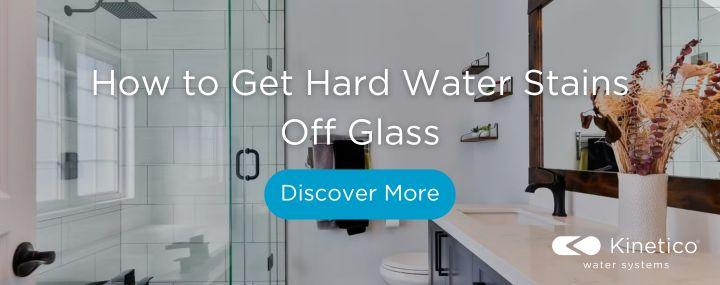Thankfully, it’s not anything to worry about so long as you don’t allow the stains to sit for too long. There are also many ways to stop such stains from ever appearing, including water softeners.
What is a Hard Water Stain?
Hard water stains are often noticeable for their white, chalky look.
Hard water contains an excess of calcium and magnesium, usually as a result of its natural path (e.g. if it travels through things like chalk and limestone before entering the system). When hard water is left to evaporate, it leaves those minerals behind, creating a chalky residue.
Hard water stains aren’t necessarily dangerous to you or your appliances; they’re mainly just unsightly. However, hard water stains can cause problems if left to build.
When the leftover minerals build up, hard water stains turn into limescale, which can impact the health and performance of any impacted appliances. Hard water stains can also contain small amounts of iron, which can cause stains and marks if left uncleaned for too long.
Golden Rules for Cleaning Stainless Steel
You’ll be pleased to hear that hard water stains are very easy to clean. In fact, you can do a good job with many household cleaners and a few cloths.
Before you start coating and scrubbing your surfaces, though, here are some general pieces of advice you should follow.
Read Your Manufacturer’s Guidance
Before you jump into cleaning your stainless steel appliance, we strongly recommend reading the manufacturer’s guidelines.
Not all stainless steel is the same, so some methods might be more effective (and others not recommended) for your product.
Always Scrub With the Grain
This is one of the most important rules you can follow when scrubbing any stainless steel surface.
One of the most common reasons why stainless steel becomes dull is because it’s been scrubbed against the grain. If you want to make sure your surfaces keep their sheen, follow the grain whenever cleaning them.
Can’t find the grain direction on your stainless steel? Usually, you can see it if you look closely (similar to seeing the grain in wood) but you can also sometimes feel it; start scrubbing slowly in multiple directions and feel where there is more or less resistance.
Three Easy Methods to Remove Hard Water Stains from Stainless Steel
You might not be surprised to hear that the best methods of cleaning hard water stains from stainless steel involve some classic household cleaning products.
Baking Soda
Baking soda is a great cleaner in many areas but it’s particularly useful against limescale.
- Mix baking soda and water to create a paste and apply it to the stains.
- Allow the paste to work for a few minutes.
- Scrub the paste with an old toothbrush or similar, non-abrasive brush.
- Rinse and wipe clean.
Alternatively, you can rinse the surface clean and sprinkle the baking soda on top for a similar effect.
White Vinegar
White vinegar is another well-trusted household cleaner and it’s equally effective when it comes to cleaning hard water stains.
- Create a solution of equal parts white vinegar and water in a spray bottle.
- Spray the vinegar solution onto the stains and allow it to work for 15-30 minutes, depending on the severity of your stain. If the stain begins to dry during that time, just spray on more solution.
- Scrub the area with a cloth or sponge, then rinse and dry with another cloth.
If you don’t like the smell of white vinegar, you can also use pure lemon juice alongside it or as an alternative. Lemon juice can be even more acidic, which is ideal for cleaning hard water stains.
Combining White Vinegar and Baking Soda
If your hard water stains are particularly stubborn, you can use a combination of baking soda and white vinegar for an even stronger effect.
- Apply baking soda to the stain as described above.
- Produce a white vinegar solution as described above and spray it onto the baking soda. This should cause the baking soda to fizz.
- Let the baking soda work until it stops fizzing (usually only a few minutes).
- Rinse with clean water and dry with a cloth or towel.
How to Prevent Hard Water Stains on Stainless Steel
Having to regularly deal with hard water stains can be hugely frustrating. If you’ve done enough scrubbing for a lifetime, there are things you can do to stop hard water stains from becoming a problem.
Cleaning Early is Much Easier
With hard water, stubborn stains can be easily avoided by cleaning early and regularly.
If you’re able to find five minutes daily, simply wiping your surfaces with water and a damp cloth can be enough to remove chalky residue before it becomes a more stubborn problem.
Protect Surfaces with Polish or Oil
Coating your stainless steel surface with polish can be a really helpful trick for stopping stains from sticking.
If you don’t want to use polish, olive or lemon oil make helpful alternatives. Once you’ve cleaned the surface, simply dab some oil on with a cloth. The thin coat will stop hard water (and other stains like fingerprints) from settling onto the surface.
Install a Water Softener
Remember, hard water stains are a natural result of the water itself. If you’ve had enough of white streaks on your surfaces, the best thing you can do is install a water softener.
Kinetico water softeners reduce the hardness of your water at source, eliminating the risk of hard water stains and limescale throughout the home. Not only does that mean reduced stains but it also improves the lifespan of your appliances, saving you money in the long term.
If you’re interested in improving the quality of your home water, explore our range of water softeners and filters today.


